A traveler is to be revered as such.
His profession is the best symbol of our life.
Going from-toward;
it is the history of
every one of us.
-Henry David Thoreau (1817-1862)
This is more of our tour, Roman Highlights.
His profession is the best symbol of our life.
Going from-toward;
it is the history of
every one of us.
-Henry David Thoreau (1817-1862)
This is more of our tour, Roman Highlights.
These photos bring back so many memories of our trip, and recall so many things
that I had forgotten. There was so much to see and take in and experience...
that I had forgotten. There was so much to see and take in and experience...
A view of the Pantheon from the square.
The Piazza della Rotonda is a piazza (city square) in Rome, Italy, on the south side of which is located the Pantheon. This rectangular square has at its center an eighteenth-century fountain crowned with an obelisk.
The constantly crowded square is situated in the historic center of Rome.
More about the... Piazza della Rotonda
Not far is the Piazza Navona, one of Rome's most beautiful squares.
The Piazza della Rotonda is a piazza (city square) in Rome, Italy, on the south side of which is located the Pantheon. This rectangular square has at its center an eighteenth-century fountain crowned with an obelisk.
The constantly crowded square is situated in the historic center of Rome.
More about the... Piazza della Rotonda
Not far is the Piazza Navona, one of Rome's most beautiful squares.
Fountain of Neptune at
Piazza Navona
Fountain of Neptune Piazza Navona, Rome
http://travelthroughitaly.com/fountain-of-neptune-rome/
Piazza Navona
Fountain of Neptune Piazza Navona, Rome
On the northern end is the Fountain of Neptune created by Giacomo della Porta in
1574. Originally it was called Fountain of The Kettle Makers because it was near a
street were all the kettle makers had their shops together with other metal based
businesses. For the first 300 years the fountain was without statues but only had the lower basin,
made out of white marble and the upper part which is made out of a local stone.
In 1878, a statue of Neptune battling an octopus was added in the middle of the
fountain by Antonio della Bitta. Gregorio Zappalà, created the other 8 marine
sculptures featuring two sea horses, two cherubs, two dolphins, and two sea nymphs.
Those features were added to fit in with the theme of the other fountains in Piazza
Navona.
http://travelthroughitaly.com/fountain-of-neptune-rome/
Fountain of the Four Rivers with Egyptian obelisk.
Situated in the center of Piazza Navona, the Fountain of the Four Rivers is one of the greatest masterpieces of Gian Lorenzo Bernini (1598- 1680). The four human figures emerging from a landscape of rocks and caves symbolize the great rivers of the four continents known at that period: the Nile, the Ganges, the Danube and the Rio de la Plata. It is said that the character representing the Nile hides his eyes so as he doesn’t see the Church of St. Agnes in Agony by Francesco Borromini’s, who was a great rival of Bernini. In fact, the gesture is an allusion to the
unknown source of the Nile. Moreover, the fountain was completed before the church was built.
http://www.nonsolowmeeting.com/eventi/romes-squares-navona-square-pantheon-trevi-fountain-spanish-steps/
Sant’Agnese in Agone
Borromini’s church, called Sant’Agnese in Agone, is a wonderful example of a Baroque façade – it’s dynamic, with all kinds of curves and countercurves, theatrical, and monumental. This was a time when the popes were trying to convince the masses that the Catholic church was still a good thing (following attacks by Martin Luther during the Protestant Reformation), and so the architecture of the day was designed to attract people. Many Baroque facades are concave, so that as you walked by, you would be almost drawn in by the shape of the building, following the curve until you reached the front door.
The church here is dedicated to St Agnes, who was a Roman martyr, a girl about 14 years old who was Christian in the days when Christianity was still illegal.
Her religion was discovered, and the pagan persecutors decided to publicly humiliate her by exposing her nude, here, in what used to be the old stadium, in front of thousands of spectators. When they tore off her toga, her hair came miraculously undone from the bun it was held in, and covered her exposed flesh. Then they tried to burn her alive, but just as the flames got going, a miraculous wind picked up and blew the flames out. At that point, they decided just to decapitate her, and that is in fact how she died. And, her head is actually on display inside the church today! The rest of her body lies several miles away in a church called Sant’Agnese fuori le Mura, or St Agnes outside the Walls, built over the catacombs where she was originally buried, head and all, along the via Nomentana, northeast of the center. When burials were allowed in the city, they started bringing the body parts of some of the saints back to the center, and Agnes’s head was brought here. The name of this church, Sant’Agnese in Agone, means “in competition,” why? For the ancient competitions that took place here in the old stadium, where she was killed.
The church here is dedicated to St Agnes, who was a Roman martyr, a girl about 14 years old who was Christian in the days when Christianity was still illegal.
Her religion was discovered, and the pagan persecutors decided to publicly humiliate her by exposing her nude, here, in what used to be the old stadium, in front of thousands of spectators. When they tore off her toga, her hair came miraculously undone from the bun it was held in, and covered her exposed flesh. Then they tried to burn her alive, but just as the flames got going, a miraculous wind picked up and blew the flames out. At that point, they decided just to decapitate her, and that is in fact how she died. And, her head is actually on display inside the church today! The rest of her body lies several miles away in a church called Sant’Agnese fuori le Mura, or St Agnes outside the Walls, built over the catacombs where she was originally buried, head and all, along the via Nomentana, northeast of the center. When burials were allowed in the city, they started bringing the body parts of some of the saints back to the center, and Agnes’s head was brought here. The name of this church, Sant’Agnese in Agone, means “in competition,” why? For the ancient competitions that took place here in the old stadium, where she was killed.
http://www.myromeapartment.com/rome-city-guide/ancient-and-old-rome-tour/
Doug at Fountain of the Four Rivers
Living statues on the square.
Fontana del Moro
At the southern end is the Fontana del Moro. It was built in 1574 built by Giacomo Della Porta during the reign of the Pope Gregorio XIII Boncompagni. In the year 1653 it completely got renovated and the Pope Innocent 10th, related to the Pamphili family had the job done by Bernini.
The central figure standing in a shell which is mistakenly called the Moor “il Moro”because of his facial features, is actually a Triton or Neptune taming a dolphin.
Fontana del Moro is one of the most ancient fountains of the Renaissance Period. When restoring the fountain Bernini had added this figure. Before the Moor statue was added, Bernini had first made a snail which the roman population and the Pamphili family didn’t like at all and was therefore removed. Four other Tritons, which is a mythical Greek God – a messenger of the sea, surround him. The fountain was renovated again in 1874 and the original statues were moved to the Borghese gallery and replaced with the copies you see today. During the month of September 2011 a vandal attacked this fountain with a hammer. The Italian authorities had everything fixed shortly after.
The central figure standing in a shell which is mistakenly called the Moor “il Moro”because of his facial features, is actually a Triton or Neptune taming a dolphin.
Fontana del Moro is one of the most ancient fountains of the Renaissance Period. When restoring the fountain Bernini had added this figure. Before the Moor statue was added, Bernini had first made a snail which the roman population and the Pamphili family didn’t like at all and was therefore removed. Four other Tritons, which is a mythical Greek God – a messenger of the sea, surround him. The fountain was renovated again in 1874 and the original statues were moved to the Borghese gallery and replaced with the copies you see today. During the month of September 2011 a vandal attacked this fountain with a hammer. The Italian authorities had everything fixed shortly after.
http://travelthroughitaly.com/fontana-del-moro-piazza-navona-rome/
Leaving Piazza Navona.
Following our tour guide, Stefano, through the streets of Rome
to Piazza Della Rotonda where the Pantheon is located.
to Piazza Della Rotonda where the Pantheon is located.
The Pantheon
In the center of the Piazza Rotonda is a fountain, the Fontana del Pantheon, surmounted by an Egyptian obelisk. The fountain was constructed by Giacomo Della Porta under Pope Gregory XIII in 1575, and the obelisk was added to it in 1711 under Pope Clement XI.
http://en.wikipedia.org/wiki/Piazza_della_Rotonda
The level of the square is the lowest in the historical center of Rome.
The level of the square is the lowest in the historical center of Rome.
http://rometour.org/piazza-della-rotonda-and-its-fountain-fontana-del-pantheon-rome.html
A Little History
Before the current Pantheon was built, two other buildings occupied the same site.
The first one, a traditional rectilinear, T-shaped structure was built in 27-25 BC by general Marcus Agrippa, son-in-law of Emperor Augustus. The temple was dedicated to the gods Mars and Venus. It burned down in 80 AD but was rebuilt by Emperor Domitian. In 110 AD the building was struck by lightning and burned down again.
In 118 AD Emperor Hadrian ordered for the Pantheon to be rebuilt again but this time in a totally different, circular design. It was completed seven years later, in 125 AD. This latest version of the Pantheon would stand the test of time much better: it is still standing almost intact today.
When approaching the front of the Pantheon one can see the inscription above still reads in Latin the original dedication by Marcus Agrippa. The inscription reads:
"M. AGRIPPA.L.F.COSTERTIUM.FECIT”
“Marcus Agrippa son of Lucius, having been consul three times made it”.
http://www.rome.info/pantheon/
The portico's sixteen huge, sixty tons weighing columns were quarried in Egypt. They were transported all the way to Rome using barges and vessels. The columns, each one with a diameter of 1.5 meters, support a pediment with an inscription attributing the Pantheon to Marcus Agrippa even though it was built by Hadrian.
In Ancient Times the pediment was decorated with statuary in gilt bronze. These were removed on the orders of pope Urban VIII to create the baldachin in the St. Peter's Basilica.
www.aviewoncities.com/rome/pantheon.htm
The bronze doors leading into the building (which are original and were once covered in gold) weigh 20 tons each. The walls of the Pantheon are 7.5m (25 ft.) thick
http://www.sacred-destinations.com/italy/rome-pantheon
The Pantheon's huge dome is a perfect hemisphere of cast concrete, resting on a solid ring wall. Outside, the dome is covered in almost weightless cantilevered brick.
This most remarkable part of the building
is more than forty-three meter high dome.
It was the largest dome in the world
until 1436 when the Florence Cathedral was constructed.
It is a Roman temple dedicated to all the gods of pagan Rome.
It was later converted into the church of Santa Maria ad Martyres.
The Pantheon was dedicated to pan theos, "all the gods." When it became a church, it was dedicated to the Virgin Mary and all the martyrs.
The Pantheon is the burial place of several important Italians (including the artist Raphael),
and it remains an active church. It is a major tourist destination and a popular place for weddings
and it remains an active church. It is a major tourist destination and a popular place for weddings
http://www.sacred-destinations.com/italy/rome-pantheon
At the top of the dome is a large opening, the oculus, which was the only source of light.The oculus was never covered and rain falls into the interior and runs off the slightly convex floor to the still functioning Roman drainpipes underneath.
Dome
The most important problem the Romans faced during the construction of the Pantheon was the massive weight of the large dome. In order to support it without proper reinforcement as is common today, the thickness of the walls was gradually decreased as the height increased.
The Romans also used a different type of concrete for the dome than for the walls. At the base very thick (6m, 20ft) walls were constructed. At the top of the dome, a lighter type of concrete was used and near the oculus it is only 7.5 ft or 2.3 m thick. The use of coffers in the ceiling and the opening at the top also helped reduce the weight of the dome.
http://www.aviewoncities.com/rome/pantheon.htm
The sunlight is shining on the walls through the oculus.
Originally a temple for all pagan gods, the temple was converted into a church in 609.
The Pantheon now contains the tombs of the famous artist Raphael and of several Italian kings.
Its ecclesiastical interior design contrast with the temple's structural design, but the marble floor - which features a design consisting of a series of geometric patterns - is still the ancient Roman original.
The Pantheon now contains the tombs of the famous artist Raphael and of several Italian kings.
Its ecclesiastical interior design contrast with the temple's structural design, but the marble floor - which features a design consisting of a series of geometric patterns - is still the ancient Roman original.
http://www.aviewoncities.com/rome/pantheon.htm
Information on Pantheon taken from: http://www.aviewoncities.com/rome/pantheon.htm
We are continuing our journey through the streets of Rome going on to
Trevi Fountain.
Trevi Fountain.
Visitors to Rome soon notice how many of its streets and alleyways are paved with cobblestones. They're very much part of the fabric of the historic heart of the city.
They are made of the volcanic rock that welled up in the hills behind the city.
And each stone is very slightly different - each has taken different blows from a chisel as it was knocked into shape.
Cobblestones in Rome are known as "Sampietrini", which translates as "little St Peters".
In this most Catholic of cities you sometimes hear that there are supposed to be
"as many cobbles as there are souls that St Peter saved."
"as many cobbles as there are souls that St Peter saved."
But the stones probably got their name because the first place where they were put down was on St Peter's Square. And it remains today a vast expanse of cobbles.
However...
But while the tourists may admire them, many Romans are far from keen.
A local newspaper recently put it like this:
"Only the tourists and the angels love the cobblestones unconditionally."
The rest of us, those who have the stones under our feet or under our wheels every day, detest them, or fear them... or admire them from a distance."
And the stones are smooth. They can be slippery in the rain - treacherous if you are on a scooter. When it snows, each small, square cobble was like an ice cube.
So the council is gradually working to remove the stones from the busier stretches of road - laying tarmac to ease and speed the traffic.
http://www.bbc.com/news/magazine-22639754
As a tourist, I hope they don't.
However...
But while the tourists may admire them, many Romans are far from keen.
A local newspaper recently put it like this:
"Only the tourists and the angels love the cobblestones unconditionally."
The rest of us, those who have the stones under our feet or under our wheels every day, detest them, or fear them... or admire them from a distance."
And the stones are smooth. They can be slippery in the rain - treacherous if you are on a scooter. When it snows, each small, square cobble was like an ice cube.
So the council is gradually working to remove the stones from the busier stretches of road - laying tarmac to ease and speed the traffic.
http://www.bbc.com/news/magazine-22639754
As a tourist, I hope they don't.
The streets of Rome are very naroow.
Views of the street levels,
This is a mall in Rome.
Inside the mall.
Beautiful!
On to Trevi Fountain
The Fontana di Trevi - or Trevi Fountain in English -is a fountain in Rome, Italy.
It is the largest Baroque fountain in the city and the most beautiful in the world.
The Trevi fountain is a imposing fountain
that served as a display of an ancient roman acqueduct termination.
that served as a display of an ancient roman acqueduct termination.
Starting from the early renaissance the popes start to decorate the end of the acqueducts they restored with large fountains that were richly decorated.
The fountain is 26,30 m high (85.28 feet, 118 roman palms), 49,15 large (160.72 feet, 220 roman palms). Every day it spills 80.000 cubic meter of water (2,824,800 cubic feet).
The main statue of the fountain does not represent Neptune, but Ocean.
Instead, as its designer Nicola Salvi wrote, the statue is an image of Ocean, the personification of a immense river that flows around the earth and from which all strams of water derive.
The beard of Ocean is symbol of wisdom and power.
His look is fiercely majestic and gentleman at the same time. In his right hand he hold the wand in act of command. His left hand holds a cloth around his pelvis to cover his nudity.
http://www.trevifountain.net/description.htm
The design of the trevi fountain is based on three architectural elements: a façade made of travertine; statues of carrara marble; a see reef also made of travertine.
The main statue of the fountain does not represent Neptune, but Ocean.
Instead, as its designer Nicola Salvi wrote, the statue is an image of Ocean, the personification of a immense river that flows around the earth and from which all strams of water derive.
The beard of Ocean is symbol of wisdom and power.
His look is fiercely majestic and gentleman at the same time. In his right hand he hold the wand in act of command. His left hand holds a cloth around his pelvis to cover his nudity.
http://www.trevifountain.net/description.htm
A traditional legend holds that if visitors throw a coin into the fountain,
they are ensured a return to Rome.
Happy 2nd Anniversary, Doug!
Throwing Coins in the Trevi Fountain
As mentioned, there’s a long-standing tradition about throwing coins in the Trevi Fountain –
The original legend says that if you throw a coin into the Trevi – with your back to the fountain, throwing the coin with your right hand over your left shoulder – that will ensure a return to Rome.
The tradition gained popularity after it was the theme of the 1954 romantic comedy
Three Coins in the Fountain,
but it started long before the movie. Originally, it was said that a thirst quenching glass of water from the Trevi Fountain would ensure good fortune and a fast return to the Eternal City. Over time the legend of the Trevi Fountain evolved to tossing a coin in to ensure a return to Rome.
http://luxeadventuretraveler.com/legend-of-the-trevi-fountain/
The second legend inspired the film "Three Coins in the Trevi Fountain",
which says you must throw three coins into the fountain: the first guarantees your return to Rome, the second leads to a new romance, while the third will lead to marriage!
Well, Doug, it looks like we will be returning to Rome! Yes!
http://luxeadventuretraveler.com/legend-of-the-trevi-fountain/
The second legend inspired the film "Three Coins in the Trevi Fountain",
which says you must throw three coins into the fountain: the first guarantees your return to Rome, the second leads to a new romance, while the third will lead to marriage!
http://www.welcometorome.net/en/about-rome/things-not-to-miss/coins-into-the-trevi-fountain
An estimated 3,000 Euros are thrown into the fountain each day.
The money has been used to subsidize a supermarket for Rome's needy; however, there are regular attempts to steal coins from the fountain.
It turns out that there’s an even better reason to toss your coin into the Trevi Fountain than just wishing for a return trip to Rome. Each day the gushing torrents of the Trevi Fountain are silenced for one hour while city workers sweep the coins from the fountain. Since 2006, the year I tossed my own first coin into the Trevi Fountain, the Roman Catholic charity Caritas has been sorting and cleaning the daily loot from the fountain.
Caritas runs food and social programs for the needy and oppressed in 200 countries and territories worldwide. Somewhere around €3000 is collected nightly from the Trevi Fountain (about $1.26 million annually) and distributes it amongst the needy. Caritas even opened a low-cost supermarket in Rome in 2008 for the needy.
http://luxeadventuretraveler.com/legend-of-the-trevi-fountain/
There are vast crowds around the fountain.
It takes a little maneuvering to find your way to the edge to throw
a coin into the fountain.
Making our way to The Spanish Steps.
The Column of the Immaculate Conception or la Colonna della Immacolata, is a nineteenth-century monument in central Rome depicting the Blessed Virgin Mary,
The column was dedicated on December 8, 1857
Atop the column is a bronze statue of the Virgin.
The standard imagery of the immaculate conception is used: a virgin on a crescent, atop the world, stomping a serpent.
The Corinthian column itself was sculpted in ancient Rome, and was discovered in 1777 during the construction of the monastery of Santa Maria della Concezione.
The Spanish Steps
They are a little crowded!
The Spanish Steps is a staircase constructed using 138 steps.
Designed in 1723 by Francesco De Sanctis, and funded by a French diplomat Stefano Gueffierwas, the steps are a mix of curves, straight flights, vistas, and terraces. It was built in order to link the the Trinità dei Monti church that was under the patronage of the king of France, with the Spanish square below. The long, triangular Spanish square is named after the Spanish Embassy to the Holy See. In the 17th century, the area around the embassy was even considered Spanish territory.
On to the Fashion District of Rome!
Piazza di Spagna
Perhaps the most famous shopping district in Rome is the area surrounding Piazza di Spagna, at the base of the Spanish Steps. Tourists flock here to see the flagship stores of Italian designer lines like Prada, Gucci, Etro, Dolce & Gabbana, Miu Miu, Bottega Veneta, Missoni, Versace, Tod's . . . the list seems almost endless. You'll also find Chanel, Louis Vuitton, Wolford, Sephora, Jimmy Choo, Tiffany and other big global brands.
Views of Rome
Now on to our Anniversary lunch at this Ristorante & Pizzeria ...
Anniversary Lunch
The next blog will have a recipe for the pizza we ordered here.
It will be an estimation of the ingredients that made for a perfect lunch!
It takes a little maneuvering to find your way to the edge to throw
a coin into the fountain.
Making our way to The Spanish Steps.
The Column of the Immaculate Conception or la Colonna della Immacolata, is a nineteenth-century monument in central Rome depicting the Blessed Virgin Mary,
The column was dedicated on December 8, 1857
The Pope comes every year on Dec 8th to lay a wreath in the arms of the statute of the Virgin at the top of the Column.
The standard imagery of the immaculate conception is used: a virgin on a crescent, atop the world, stomping a serpent.
The Corinthian column itself was sculpted in ancient Rome, and was discovered in 1777 during the construction of the monastery of Santa Maria della Concezione.
At the base are four statues of Hebrew figures that gave portent of the virgin birth, each accompanied by a quote of a biblical verse in Latin, including David (by Adam Tadolini), Isaiah (by Salvatore Revelli), Ezekiel (by Carlo Chelli), and Moses (by Ignazio Jacometti).
http://en.wikipedia.org/wiki/Column_of_the_Immaculate_Conception,_Rome
They are a little crowded!
The Spanish Steps is a staircase constructed using 138 steps.
Designed in 1723 by Francesco De Sanctis, and funded by a French diplomat Stefano Gueffierwas, the steps are a mix of curves, straight flights, vistas, and terraces. It was built in order to link the the Trinità dei Monti church that was under the patronage of the king of France, with the Spanish square below. The long, triangular Spanish square is named after the Spanish Embassy to the Holy See. In the 17th century, the area around the embassy was even considered Spanish territory.
http://romeonsegway.com/7-facts-about-the-spanish-steps/
On to the Fashion District of Rome!
Piazza di Spagna
Perhaps the most famous shopping district in Rome is the area surrounding Piazza di Spagna, at the base of the Spanish Steps. Tourists flock here to see the flagship stores of Italian designer lines like Prada, Gucci, Etro, Dolce & Gabbana, Miu Miu, Bottega Veneta, Missoni, Versace, Tod's . . . the list seems almost endless. You'll also find Chanel, Louis Vuitton, Wolford, Sephora, Jimmy Choo, Tiffany and other big global brands.
http://www.tripadvisor.com/Travel-g187791-s405/Rome:Italy:Shopping.html
Views of Rome
Now on to our Anniversary lunch at this Ristorante & Pizzeria ...
Anniversary Lunch
The next blog will have a recipe for the pizza we ordered here.
It will be an estimation of the ingredients that made for a perfect lunch!












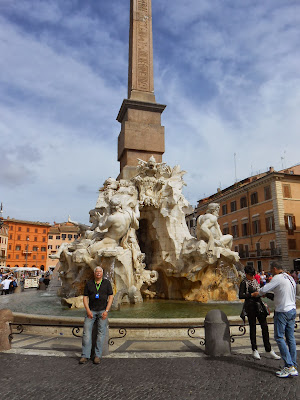
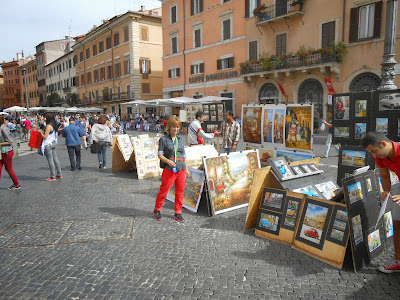

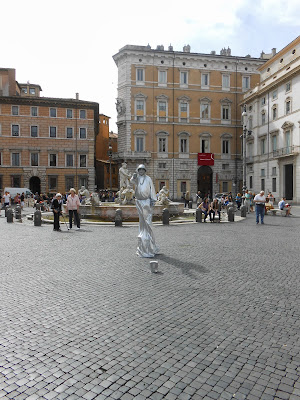


















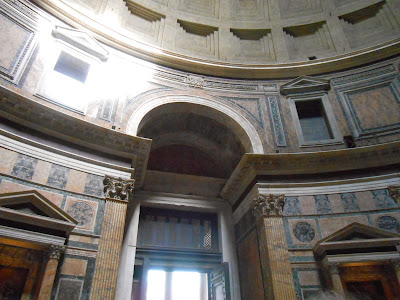









































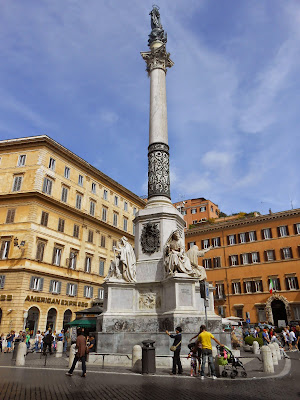














No comments:
Post a Comment